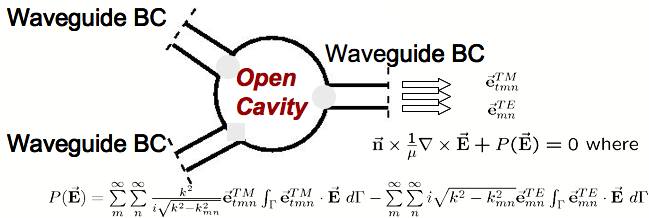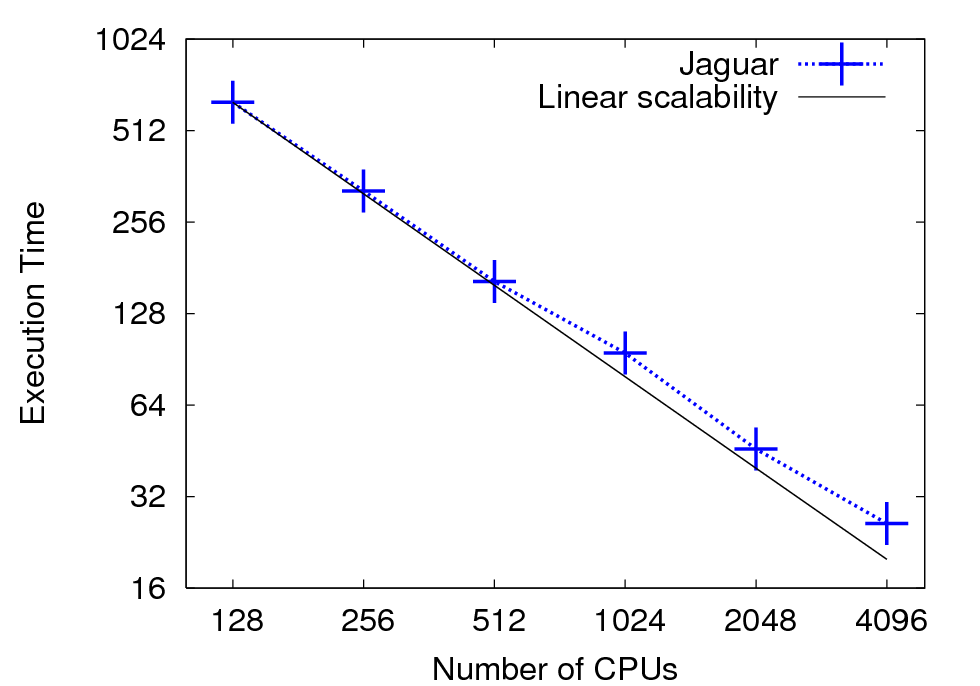Introduction
Omega3P is a parallel finite-element electrogmagnetic code for high-fidelity modeling of cavities. It calculates the resonant frequencies and other rf parameters of a cavity, as well as damping effects due to external couplings. It uses Nedelec-type hierarchical vector basis up to 6th order with quadratic (10-points) tetrahedral elements for improved solution accuracy.
Mathematical Modeling
Lossless cavities
Maxwell's equations in the frequency domain for a perfectly conducting cavity can be written as the following PDE,
\begin
\nabla \times \left(\frac
\nabla \times \vec
& = 0 & on \quad \Omega
\vec
\times \vec
& = 0 & on \quad \Gamma_
\vec
\times \left( \frac
\nabla \times \vec
\right) & = 0 & on \quad \Gamma_
\end
We use Nedelec-type vector basis functions to discretize the electric field:
[\vec
=\sum_i x_i \vec
_i]
We obtain the following generalized eigenvalue problem:
\begin
= k^2
\quad where &
_
= \int_
\left( \nabla \times \vec
_i \right) \cdot \frac
\left( \nabla \times \vec
_j \right) d\Omega &
_
= \int_
\vec
_j d\Omega &
\end
The matrix K is real symmetric while M is real symmetric positive definite. If there are lossy materials in the cavity, the matrix M and/or K will be complex.
Waveguide loaded cavities
For modeling waveguide-loaded cavities, we use either the absorbing boundary condition (ABC) or the waveguide boundary condition (WBC). The following picture illustrates a cavity with 3 waveguides, and each of them is modeled with ABC.
The discretized system is a complex nonlinear eigenvalue problem,
[
+ i \sum_j \sqrt{k^2-k^2_{cj}}
_j
= k^2
]
where the damping matrix W is
[
(
j)
= \int_
\left( \vec
\times \vec
_m \right) \cdot \left( \vec
\times \vec
_n \right) d\Gamma
]
The following picture illustrates a cavity with waveguides, which are modeled with WBC.
The corresponding discretized system becomes a complex nonlienar eigenvalue problem,
[
+ i \sum_
\sqrt{k^2-(k^
_
)^2}
^
_
+ i \sum_
\frac
{\sqrt{k^2-(k^
_
)^2}}
^
_
= k^2
]
where the waveguide matrices are
[
(
^
_
)_
= \int_
\vec
^
_
\cdot \vec
i d\Gamma \int
\vec
^
_
\cdot \vec
_j d\Gamma
]
[
(
^
_
)_
= \int_
\vec
^
_
\cdot \vec
i d\Gamma \int
\vec
^
_
\cdot \vec
_j d\Gamma
]
Numerical Methods
The following is a graphical description of the four different types of physics problems that Omega3P can solve and the solver options that can be used.
Parallel Performance
Omega3P parallel performance is heavily dependent on the solver used. In general, using sparse direct solvers for shifted linear systems often yields higher FLOPS than using Krylov subspace iterative methods. On the other hand, the latter has much better scalability.
The following is a strong scalability plot for Omega3P running on ORNL Jaguar (Cray XT). It used 1.5 million higher-order tetrahedral elements for the RF gun of the LCLS. . The number of the degrees of freedom is about 9.6 millions, and the number of nonzeros in the resulting matrix about 506 millions. It is shown that Omega3P scales to 4096 number of CPUs with more than 95% of parallel efficiency.



